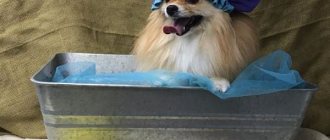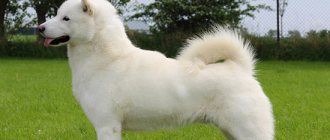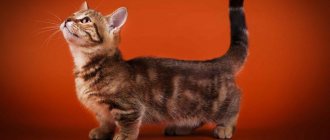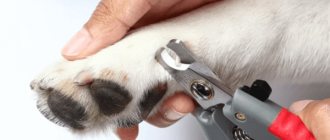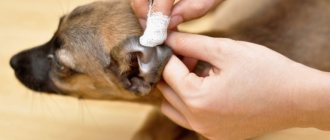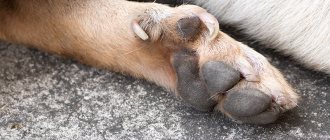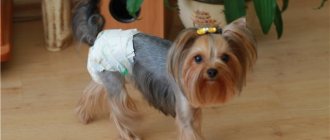Under natural conditions, animals quietly get rid of keratinized particles in the process of moving on hard surfaces, while climbing trees, hunting, etc. At home, pets do not have this opportunity, therefore, if the cat is not accustomed to a scratching post, furniture, etc., are used. walls, carpets.
Do not rush to punish the fluffy - just carry out hygienic trimming of the claws. It is performed using a special tool - a nail clipper. You can find several types of this device in pet stores.
Why do you need to do a cat manicure?
Cats' claws invariably grow, and they need to be tidied up - trimmed using a special nail clipper. Overgrown claws can cause discomfort to the animal or cause injury.
In nature, cats walk on hard surfaces or wear down their claws on trees and other convenient objects. At home, animals are deprived of this opportunity and cannot do without human help. Therefore, from time to time they need the so-called cat “manicure”.
Overgrown claws can become ingrown or cause discomfort when walking. The cat may also get caught in a carpet loop or some piece of furniture, which will lead to a finger injury and medical intervention.
When their claws grow long enough, cats begin to grind them down themselves. In the best case – on a scratching post, in the worst – on wallpaper or furniture. Timely manicure is the key to the cat’s health and the integrity of the owner’s sofa.
What is a claw cutter
People use nail scissors to take care of their nails. And for cats there is a special accessory - a nail clipper. It differs from nail scissors both visually and functionally. The appearance of a nail clipper depends on the type, although they are all roughly similar. Only the electric nail grinder is radically different.
Description of the tool
There are four types of cat nail clippers. Each one has its own individual appearance and nuances of working with it.
In a veterinary pharmacy or pet store, you will immediately recognize nail cutters: these are small pruning scissors, the blades of which have a recess for the claw. Well, the grinder looks like a plastic handle with a small rod that rotates at high speed and grinds down the claw.
It is optimal to choose a tool with a handle that is comfortable for you: it fits in size, does not slip, and does not squeeze your fingers. The blades must be serrated, sharp, smooth and shiny.
Why regular manicure accessories are not suitable
A human nail and a cat's claw have different structures and densities, which is why different care products are selected. The nail is a plate that does not itself have nerve endings and blood vessels, so when cutting, only the skin and tissue of the finger can be damaged.
The cat's claw has a hollow structure and a crescent-shaped curve. It contains blood vessels and nerve endings that are very easy to damage, causing pain and bleeding. It is much easier to injure a cat with ordinary scissors than with a nail clipper.
Another caveat: human scissors or wire cutters tear apart a cat’s claw, which leads to problems ranging from crumbling to bleeding or ingrown nails. The nail cutter cuts the plate more evenly and sharply, so the claw does not peel off.
Before you begin the nail trimming process, it is important to familiarize yourself with the basic anatomy of a cat's claw and paw and learn how to correctly determine the length that needs to be left.
Review of nail clippers
Some owners say that they are able to file their claws, but it is still much easier and more reliable to cut them off. And ordinary scissors or clippers are not very suitable for this purpose, since cat claws and human nails have completely different structures. The pet supply industry offers a large selection of devices under the general name “nail clippers” - with their help, your pet’s manicure can be done quickly and painlessly.
What are there
Nail clippers are very simple and effective tools that come in several main types:
- pliers;
- scissors;
- guillotine;
- grinder.
Despite significant design differences, all of these tools do an excellent job of their main task. All that remains is to choose exactly the device that will be most convenient in your particular case.
The best nail clipper is the one you and your cat like
The price of nail clippers is also comparable - any of them, on average, can be purchased for 200 rubles; It will cost you about the same to trim your nails at a veterinary clinic or grooming salon - but this will be the cost of only one procedure. The cheapest nail clippers are scissors, the most expensive are electric grinders.
Devices for trimming cat claws are made by many manufacturers - both well-known brands and not so well-known ones. Choose a brand whose quality you have reason to trust.
How to choose
You may need to try out different types of nail clippers before settling on one. But first, consider the capabilities, pros and cons of all the tools. And be sure to hold them in your hands before buying - you should feel comfortable.
Forceps
The principle of operation of this nail clipper, and its very appearance, is very similar to the most ordinary nippers. The claw is placed between the working surfaces, the handles are compressed - and that’s it, the sharp tip is already cut off! It will not be possible to cut off excess, because the required length is fixed, and the blades of the pliers are blocked when necessary - a special lever is provided for this.
This nail cutter is also called a pruner - it really looks like
Scissors
At first glance, cat scissors are not much different from human ones - but this is only the first impression. Nail cutter scissors are designed specifically for a hard and convex cat’s claw - they cut it in such a way as not to delaminate or injure it; For this purpose, a special round cutout is provided between the blades. Choose scissors made of good steel and with rings that are comfortable for your fingers.
Nail clipper-scissors - it's simple and convenient
Guillotine
The guillotine is perhaps the most popular device for cat manicure. This tool is easy to use; with it, the procedure goes very quickly, which is important - especially if the cat actively objects to trimming its claws. But in order to use the guillotine, you need to have certain skills in working with it. The fact is that the entire claw is not visible through the “window” at the moment of cutting it, and therefore there is a risk of causing injury to the animal.
The guillotine nail clipper requires caution when working
Grinder
An electric nail grinder is designed not for cutting, but for grinding down the sharp tips of claws - the role of a polishing “file” here is played by a quickly rotating wheel. Effective use of such a machine requires experience and skill, so the grinder is not recommended for beginners. This nail clipper is still more suitable for professional use.
Electric grinder professionally polishes cat claws
Types of devices
There are variations of nail clippers of different types, models, shapes and designs. There are some that are very easy to use - they are suitable for novice cat owners, and there are special ones designed for professional breeders and groomers.
Before going to the store, it is better to find out what the differences are between the main types of nail clippers, as well as their advantages and disadvantages.
Guillotine
This type of tool consists of two working parts: movable and fixed. Trimming is performed by a moving part, which is installed perpendicular to the claw placed in a special hole. The use of guillotine claw clippers requires certain skills, since when fixing the nail plate it is not visible. However, despite this disadvantage, guillotine-type tools are very popular - especially among owners of large cats with hard claws.
Scissor nail clipper
Scissors are the simplest solution. Outwardly, they resemble human manicures, only with rounded blades and a hole in the middle. It is intended for laying the claw and fixing it during the procedure.
The tool is very easy to use: you place a cat's claw in the notch, the handles close together, and the result is a neat, smooth cut. Suitable for small cats and kittens.
Nail clipper-secateurs
Resembles regular wire cutters or needle nose pliers. The handles have rubber linings, fit comfortably in the hand and do not slip. The spring included in the mechanism also makes working with the accessory easier. The cut is better than that of scissors.
Most models are equipped with a special limiter that sets a certain length and protects against cutting off excess. A special safety lock blocks the cutting surfaces when the pliers are not in use. There are straight and curved models on the pet products market.
Electric nail clipper or grinder
This is a power tool, so it is the most functional and expensive. During operation, the grinder head with an abrasive coating rotates and grinds down the claw plate like a nail file. The device comes with various attachments and limiters.
A beginner without the skill of working with an electric grinder can easily injure a pet by affecting the living part of the claw. Such devices are more often used in professional grooming salons. In stores you can find models that operate on mains power, batteries, and rechargeable batteries.
How to choose a nail clipper for cats
It’s best to choose a nail clipper for cats this way: whichever tool is convenient for the owner, that’s what you should buy. If the nail cutter fits well in your hand, misfires and injuries will be reduced to almost zero.
The second important point is the size of the cat and, accordingly, the size of its claws. For thin and transparent claws, on which the vessels are clearly visible, you can use scissors or nippers. If the claws are thick and large, you must use a guillotine or grinder.
The tool must be of high quality, and its blades must be dense and made of good steel. The nail clipper should not seem too light or heavy to the owner, as this can cause inconvenience and awkward movements during cutting.
How to use a nail clipper
Having decided on the choice of a nail clipper, all that remains is to learn how to use it. Follow the instructions:
- sit against the light, take the dog’s paw in your hand;
- gently press on the pad so that the claw comes out;
- examine the claw in the light - you will see where the blood vessels pass - you must not touch them;
- You need to trim the claw at a right angle in several movements;
When trimming your dog's nails, take your time. You should pause every couple of claws to calm your pet if you need to. If you are in a hurry, there is a risk of cutting off a lot at once and getting on your nerves. The dog will feel pain, and in the future the procedure will be associated with pain. If you still hit a nerve, take a break, comfort your pet, play with him. Return to cutting after about an hour and be especially careful. When you're done with the haircut, take a special file and trim the edges of the claws.
Using a nail clipper
A nail clipper should be beneficial for cats and their owners, eliminating harm and stress. To do this, the owner must be fully prepared for the procedure himself. The cat needs to be reassured and ensured that it is feeling well.
Nail trimming procedure
Before starting the procedure, you must wash your hands, your pet’s paws, and also disinfect the nail clipper itself. Next, proceed according to the steps:
- The cat should be calm. If there are signs of illness, it is better to postpone the procedure until better times. You should not cut the nails of an animal that has just eaten or is scared - it may vomit. If the cat gets nervous and struggles, it will jerk its paw and damage a claw or finger.
- It is better to pick up the cat, calmly talk to it and stroke it. This will make her more comfortable. At this point you can begin the procedure.
- The nail cutter is taken in the hand so that it fits comfortably and tightly, and it is easy for the person to control all movements. It is better to take the paw in such a way as not to pinch your fingers and not cause discomfort to the cat, acting gently but confidently.
- To make the claws clearly visible, you need to gently press the pad on the paw in the very center: the claw will come out slightly.
- Next, it is important to determine where the capillaries and nerve endings are located in the nail. To do this, you need to look at the claw in good lighting: this part will be pink. In black cats it may be brownish.
- You can cut off the entire transparent part of the claw, just short of the pink part.
It is better to file the edge with a file or buff so that there are no rough edges or nicks left.
Precautions and possible injuries
It is important to carry out the procedure cleanly and in good lighting so that the “living” part of the claw can be seen. If it is damaged, blood may bleed and the cat will be in pain, so you need to retreat 2-4 millimeters from this place.
In case of severe bleeding, immediately apply a tight bandage and, without wasting time, contact your veterinarian. Mild bleeding can be stopped with hydrogen peroxide.
If your cat has an ingrown claw, you should not try to deal with this problem on your own - it is better to immediately contact a specialist. A good grooming salon or any veterinary clinic will eliminate this nuisance.
Tool storage
A nail clipper can be classified as a pair of scissors or nippers. Due to the presence of blades, the tool is dangerous, even if it has a locking mechanism. It is better to keep it away from children and animals to avoid injuries and accidents.
The nail clipper does not require special storage conditions, but you should not place it with objects that could damage the blades. It is also recommended to keep it away from water and damp places.
How to use a nail clipper
Having decided on the choice of a nail clipper, all that remains is to learn how to use it. Follow the instructions:
- sit against the light, take the dog’s paw in your hand;
- gently press on the pad so that the claw comes out;
- examine the claw in the light - you will see where the blood vessels pass - you must not touch them;
- You need to trim the claw at a right angle in several movements;
When trimming your dog's nails, take your time. You should pause every couple of claws to calm your pet if you need to. If you are in a hurry, there is a risk of cutting off a lot at once and getting on your nerves. The dog will feel pain, and in the future the procedure will be associated with pain. If you still hit a nerve, take a break, comfort your pet, play with him. Return to cutting after about an hour and be especially careful. When you're done with the haircut, take a special file and trim the edges of the claws.
